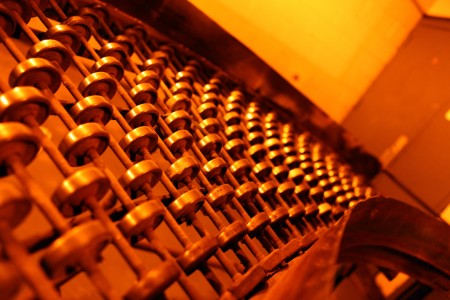When I went to visit Toronto this past weekend, I had to lug a suit bag with me. The idea of bringing along my Canon 5D Mk II digital SLR (dSLR) and associated gear and lenses was too daunting, so I brought along my little Canon A570IS point and shoot (P&S) camera instead.
It has been quite a while since I used a point and shoot, so the experience felt novel to me. Those little cameras certainly have a few things going for them:
- It can be carried in a pocket and easily held with one hand.
- Since the camera fits in a pocket, you don’t need to constantly advertise that you are carrying it.
- It can fit into small spaces, allowing for unusual compositions.
- Subjects are not intimidated by such a small camera.
- The tiny shutter is very quiet.
- The relatively low value of the camera makes you less worried about loss, damage, and theft.
- There are fewer condensation problems, since the smaller camera and lens have less thermal momentum.
- The camera takes ubiquitous AA batteries, rather than expensive proprietary cells.
- The camera can automatically detect faces, and focuses on them.
- For a small camera, a small tripod is sufficient for long-exposure shots. It is also easier to brace a small camera on most horizontal surfaces.
- The camera is so light, there are no problems with carrying it around everywhere, for hours.
Of course, there are a few reasons why I missed my 5D. By far the most important is image quality. The sensor in the A570IS is small and produces visibly noisy images at 200 ISO, and ones that are terrible at 400 ISO and up. By contrast, images from the 5D look very decent at 2500 ISO. Because of the superior lenses, shots taken on the 5D also look better in more subtle ways. The 5D also has a more accurate viewfinder; the shot that ends up on your memory card looks much like the one composed through the viewfinder, with minimal cropping and parallax problems.
80% of the time, the ideal option would be something that is about the size and weight of the A570IS but which has the image quality of the 5D Mk II. The rest of the time, the size and weight of the 5D would actually be preferable. In particular, all the dedicated controls spread across the 5D body make it easier to choose the ideal settings for a particular shot quickly.
Alas, for the foreseeable future there will always be the need to choose between convenience and quality.


80% of the time, the ideal option would be something that is about the size and weight of the A570IS but which has the image quality of the 5D Mk II.
It seems like the G11 might be close to what you are looking for. That or a Leica.
I went for something portable – in most situations I’m unlikely to take a heavy option with me.
I had a limited budget and a hankering for both a wide optical zoom/macro and some manual controls but decent auto functions and image stabilization (so I ended up with the Panasonic TZ8).
This has some significant downsides of course (including noise), but there are now a few (not-so cheap, not so zoomy) portable compact cameras with decent sensors these days – the Canon Powershot S95 reputedly (several of my friends have the S90) is, for a compact, really decent at avoiding noise issues and handles RAW files.
Manufacturers spec
Lumix DMC – TZ8 http://www.panasonic.co.uk/html/en_GB/Products/LUMIX+Digital+Cameras/Super+Zoom/DMC-TZ8/Specification/3378725/index.html?trackInfo=true
Canon Powershot S95 http://www.canon.co.uk/For_Home/Product_Finder/Cameras/Digital_Camera/PowerShot/PowerShot_S95/index.aspx?specs=1
The S90 / S95 are definitely highly portable and I am told the image quality is good. The biggest problem with them, for me, is how all the manual controls are buried in menus.
On my A570IS, changing things like the camera mode (aperture priority, shutter priority), aperture setting, and ISO can all be done quickly with dedicated physical controls. That is quite valuable when you want to tailor settings for each shot.
Of course, the G10 / G11 series has even more physical controls, along with a much better sensor than the A570 and lower noise.
What controls are in menus on the S95 which are on the camera body of the A570?
http://www.kenrockwell.com/canon/s95.htm
From the pictures here, I can’t see any differences. You still have a wheel to select M, P, A, T or auto, buttons to select focus mode, flash mode and exposure compensation. And a function button which, if it works like an A570, gets you to ISO control, colour mode, etc…
Currently I’m enjoying carrying around my light DSLR kit, but if I were to embark on a trip where I wouldn’t want a DSLR I think I would buy one of these. I’m actually not sure if my DSLR is any better in low light than this would be – 28mm equivalent @ F2.0, with good ISO 800 and VR? That’s pretty impressive.
I guess my recollection of handling an S95 was faulty – I thought it lacked some of the A570 controls.
Perhaps it was just that I found the controls on the S95 too small to be easy to use.
This thing seem pretty cool:
http://www.geeksaresexy.net/2011/10/21/omg-want-lytros-amazing-new-light-field-camera-video/
I would be interested in trying one out. Sometimes, especially with portraits, I do wish I could re-focus photos after the fact.
As an aside, here is an interesting comparison of a big camera and a small one.